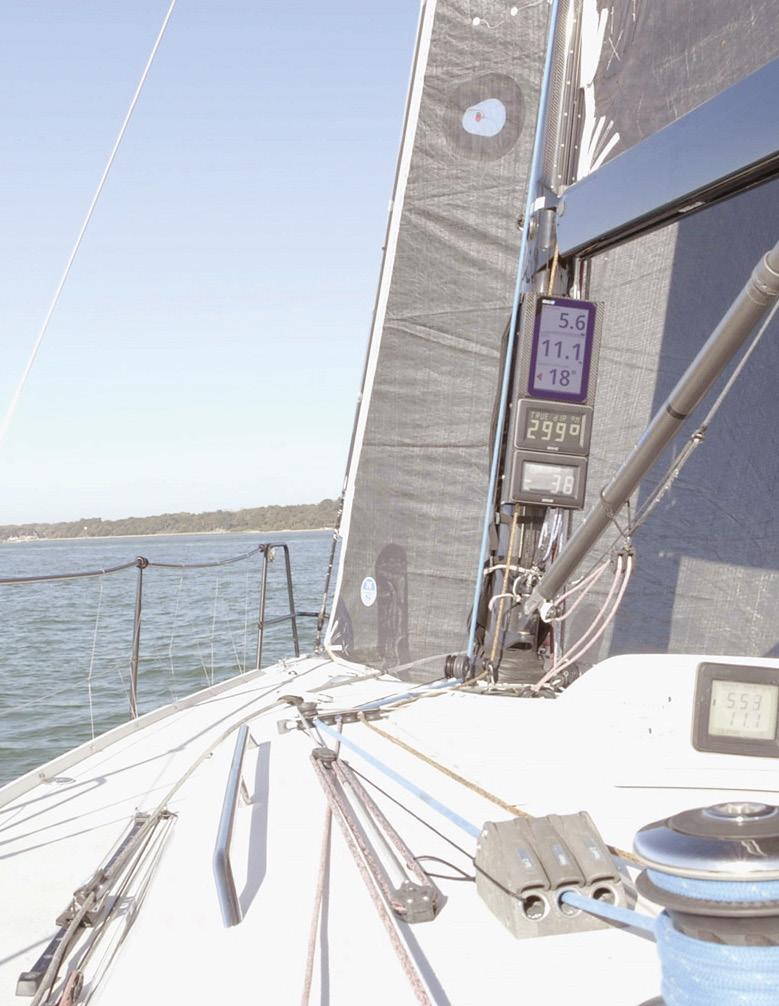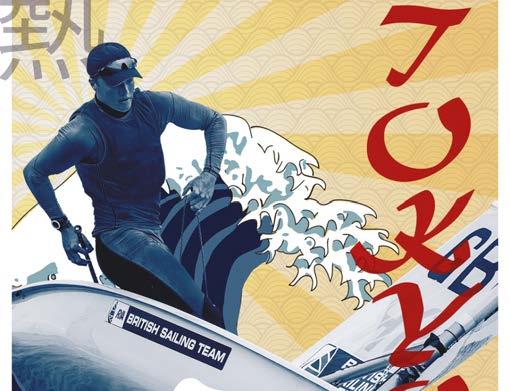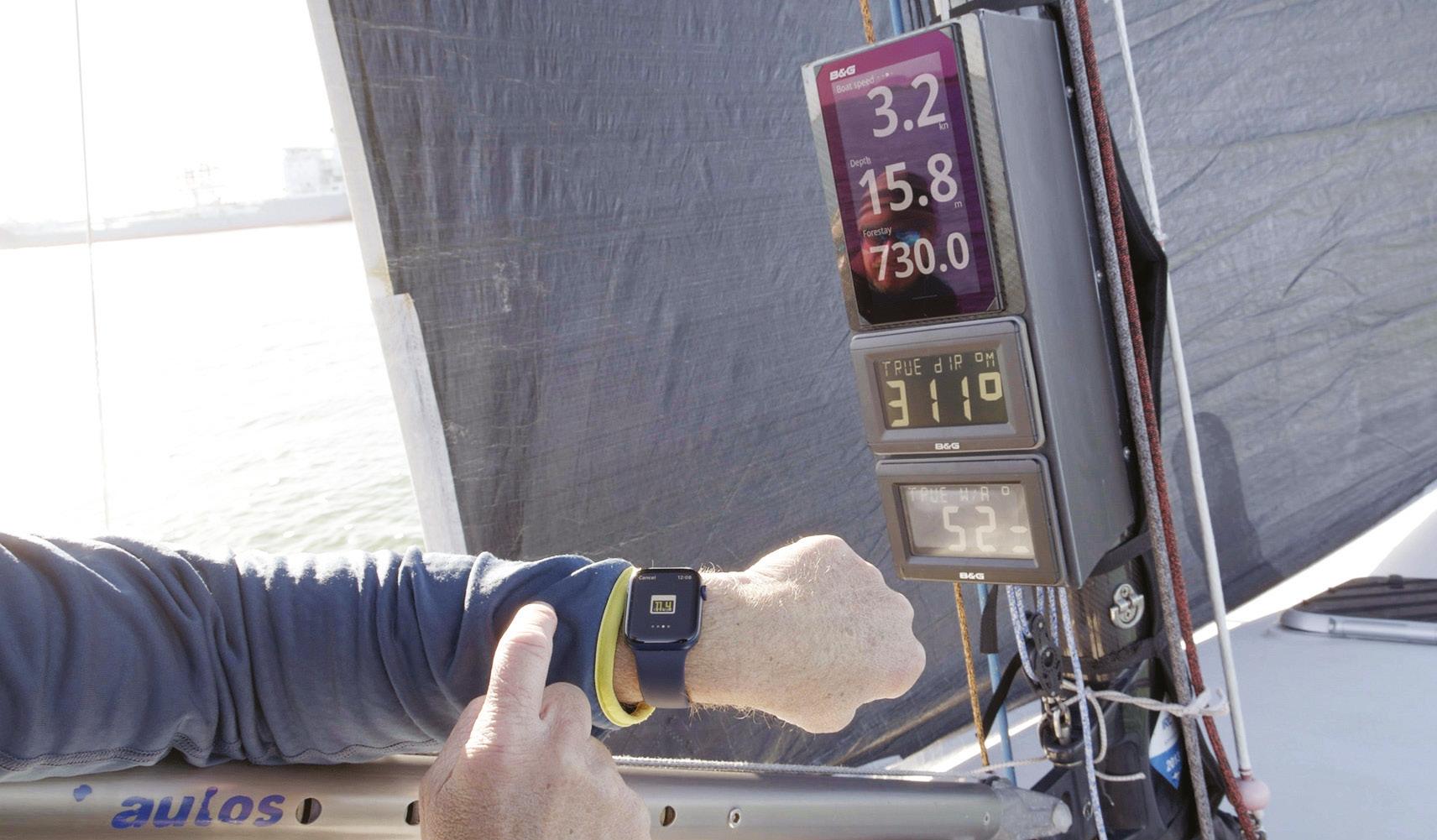
11 minute read
Buyer’s Guide
Multi Functional
It’s a sign of the times that Multi Function Displays have become the nerve centre of the modern yacht. Sam Fortescue looks at the latest upgrades
Whether your old instruments are starting to fail you, or you just want to upgrade, the four top marine electronics brands o er unprecedented repower. e multifunction displays which form the nerve centre of a modern network are more powerful than ever, with dazzling colour screens and sophisticated user interfaces. e digital charts they display have never o ered more features, from automatic route planning and user’s pub reviews to the most astonishingly detailed seabed detail – viewable in a kind of Jules Verneesque 3D. Not only that, they can be updated electronically via Wi , so no more messing about with Notices to Mariners and purple ink.
Finally, the instruments that they support are becoming more sophisticated, too. We’ll always need the basics of speed and depth, wind direction and water temperature. But to that you can add solid-state radar that tracks targets, dedicated collision avoidance and cameras for remote monitoring. Increasingly, the MFD is the portal through which you can control everything from the music streaming in the focsle to the underwater lights, via tank levels and engine diagnostics. Here is a look at what the main brands are o ering this sailing season.
remote monitoring. Increasingly, the MFD is the portal through which you can control everything from the
BELOW
Raymarine's Axiom range
Raymarine
It may seem as if it was just yesterday that Raymarine launched its new Axiom displays, but it was back in Axiom displays, but it was back in 2017, and they’ve had an important 2017, and they’ve had an important upgrade this year. Axiom has become upgrade this year. Axiom has become
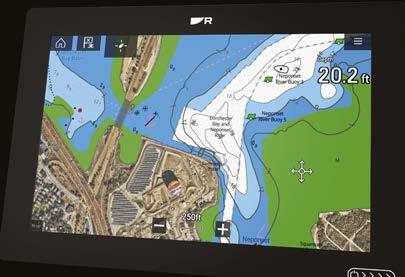
Axiom+ and now packs more processing power (brands are very reluctant to put an actual gure on this, because it compares unfavourably with fast-moving consumer goods like mobile phones). In line with the more recent Axiom XL and Axiom Pro, its internal memory has quadrupled to 16GB, paving the way for Raymarine to roll out its own proprietary Lighthouse charting (see boxout for more detail). ere’s also the new IPS screen technology, which improves viewing angles and visibility by a reported 25 per cent, according to marketing director Jim Hands. “Axiom was great before and now it’s even brighter with the Plus.” e screen has a nano-particle coating to repel water, oil and smudges more e ectively – handy in poor conditions.
Axiom+ also has a new 10Hz GPS receiver. is won’t improve accuracy much for slow cruising boats, but it is more sensitive and should mean the unit gets a faster x when you switch it on and holds that x through more sailcloth/coachroof and other obstacles. What’s more, it has been hosting apps for longer than the competition, and o ers products from PredictWind to Spotify and Net ix (astonishingly, its most downloaded app).
Raymarine instruments all run on NMEA2000, but there is a plug arrangement peculiar to the brand which means it interfaces more easily with other Raymarine equipment, rather than third party kit. at said, their range is among the broadest in the business, with solid-state radar, AIS, VHF radio, sh nders, FLIR marine cameras and hi-end audio through its more recent tie-up with Rockford-Fosgate.
Garmin
New from Garmin is the GPSMAP X3 - its next generation of mid-sized MFD. Available in 7in, 9in and 12in formats, the design has undergone similar upgrades to its two big competitors, including a sunlight viewable IPS screen and a processor with almost twice the power of the previous range. e screen of the 7in and 9in models has 50-60 per cent more pixels, and there is now a more powerful 10Hz GPS receiver. Networking gets a look-in, too, with the ability to combine digital switching, cameras, engine data and nav data. And although you can buy a bundle with Garmin’s latest SideVü and LiveVü scanning sonar, sailors will be pleased to learn that there is a sonar-free option too.
Garmin o ers a full suite of instruments to go with its displays, including solid-state radar, DST, various wind transducers (it o ers a durable horizontal axis wheel), video cameras, Fusion entertainment systems and EmpirBus digital switching. Plus, you can set up your Garmin Quatix 6x smartwatch to repeat key nav data.
Bluechart g3 is Garmin’s native chart o er, based on the Navionics charts which are available for users of any MFD. But there are some di erences. Both have the astonishingly detailed 1 contours that allow you to see the seabed in striking detail. But Bluechart g3’s premium Vision product can put this on a kind of highway view, where you have either a keel- or mast-eye view. en there’s shallow-water shading, auto route planning and
ABOVE LEFT Raymarine's Axiom 12 Plus
ABOVE RIGHT
Raymarine Lighthouse
BELOW (L-R)
Garmin's GPSMAP X3; It is now possible to perfectly discern the details of wrecks from the detailed bathymetry of modern digital charts; Garmins GM120
RAYMARINE GETS SERIOUS ABOUT CHARTING
Though Raymarine has long had basic charts, it is investing heavily in an e ort to match Garmin’s Navionics and B&G’s C-map o er. Called Lighthouse, the new charts will include street mapping, depth contours and points of interest (from shops and restaurants to marinas and slipways). Charts covering UK, Irish, French and Italian waters are already available, with UK and Ireland pricing around £145.
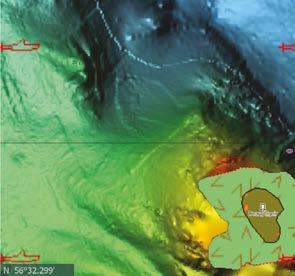
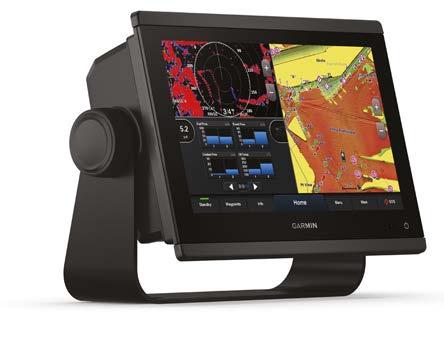
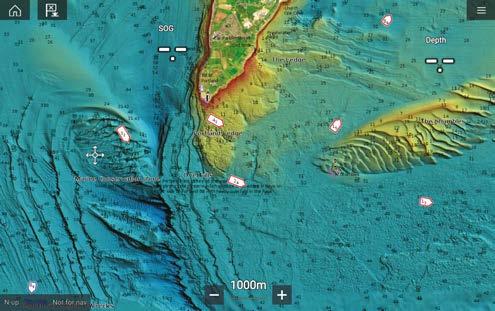
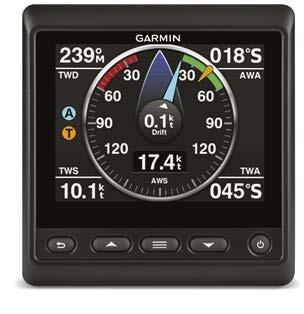
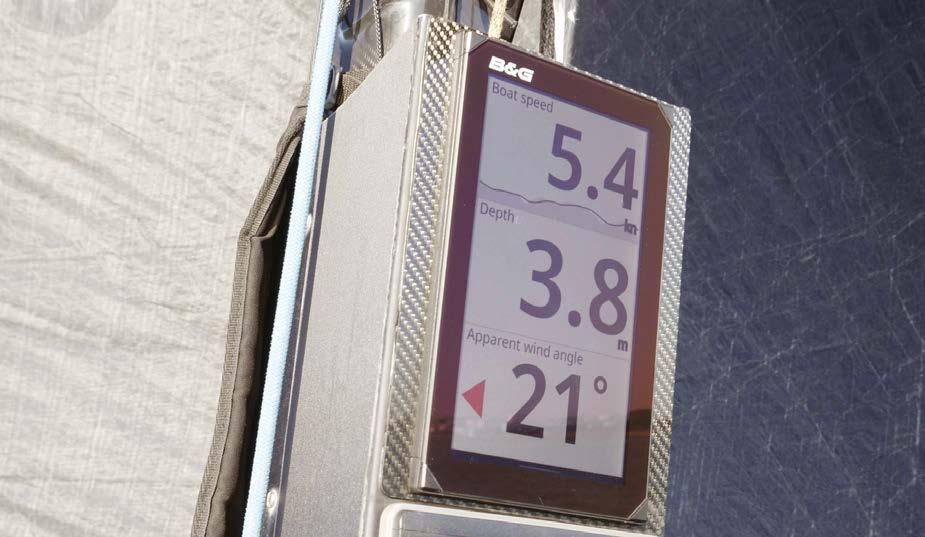
aerial photography.
Garmin’s existing ActiveCaptain app allows you to do your passage planning at home, and have it transfer across automatically to the display when you board.
GPSMAP 723 from £900
GPSMAP 1223 from £2,600
B&G
Part of the electronics behemoth that is Navico, B&G continues to dominate the market for performance sailing instruments. is year saw it launch an exciting new addition to its range of displays with the full-colour Nemesis. Designed to repeat whatever data you choose, Nemesis can be used above the mastfoot or ush mounted in the cockpit. It features a cuttingedge IPS SolarMax screen, with super-wide viewing angles, even through polarising glasses. It began life as a replacement for the popular HV unit, but became something more powerful. “We wanted a display that allowed the user to show whatever data they liked in whatever format. ey can be as creative as they like,” explains product director Matt Eeles. It comes in a 9in or 12in format and can be mounted either landscape or portrait. A really nice feature is the ability to select context pro les, so it will display di erent information on a run, for example, than on a beat.
B&G’s other big launch this season is a new souped up version of its top performing MFD, called the Zeus 3S. With the enhanced viewability of the Nemesis and a powerful quad-core processor, it is billed as keeping chart scrolling perfectly smooth, even with sonar or radar running. e other key upgrade is the ability of the Zeus 3S to run embedded apps. ese will emerge slowly in coming months, but will o er some additional functionality, such as weather forecasting or controllers for hardware elsewhere on the boat – underwater lighting is an obvious one. Zeus already o ers market leading sailing functionality, including SailSteer, RacePanel, StartLine, Laylines, Advanced Windplot and Weather routing.
Navico’s in-house charting brand C-Map has also had a relaunch. Its so-called Genesis layer adds 1 depth contours, while Reveal plots it in staggering shaded 3D that brings the seabed to life. Zeus3S is also now capable of taking a video input from Flir’s marine cameras, giving you optical, infrared and even underwater imagery. Expect a future so ware update to blend cartography, AIS data and video, for so-called ‘augmented reality’. Collision avoidance is another technology that B&G is looking at. ere is a full range of sailingspeci c instruments compatible with Zeus 3S and the cheaper Vulcan displays. B&G’s wind instruments are market leading, and range from the basic cruising model to a highmodulus carbon model for grand pric racing. ere’s also ForwardScan, a sonar product that

ABOVE LEFT B&G's Nemesis
ABOVE RIGHT
B&G's latest Wind/ Speed/Depth display in action
BELOW LEFT B&G's Vulcan 7
BELOW RIGHT Navico's C-Map
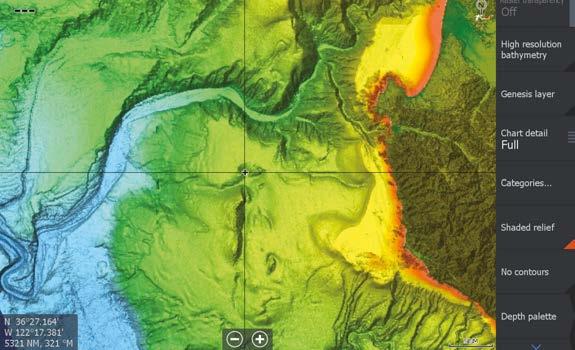
can plot the seabed ahead up to eight times the depth – so 40m ahead in 5m of water. It gives you time to crash tack to avoid grounding.
Zeus3S starts at 9in costing £2,700, up to 16in at an eye-watering £6,660. Nemesis costs £3,260 (9in) or £4,900 (12in)
b&g.com Furuno
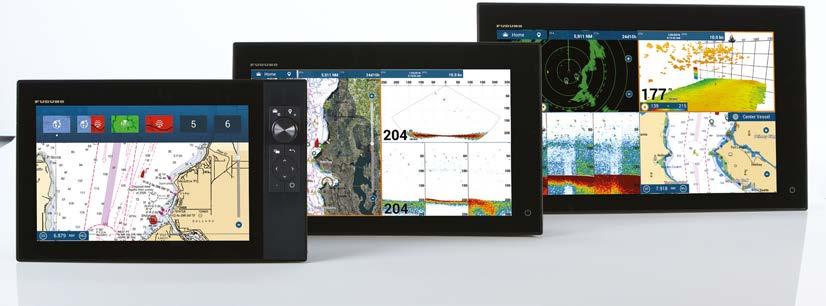
Despite its commercial vessel image, Furuno does a solid range of cruising electronics under its Time Zero Touch 3 sub-brand. Launched in early 2020 as big format 12in to 19in displays, a smaller 9in unit has just been added.
A quad-core processor gives seamless chart scrolling, with the no industry-standard IPS technology for a brighter screen and wider viewing angle. e 9in and 12in displays also o er hybrid controls, with buttons and a dial that is more practical than a touchscreen in wet conditions.
Furuno makes its own AIS, VHF radio, satellite compass, wind transducer, plus DST and even sh nding sonar. It also o ers a very capable solid-state Doppler radar in the form of the DRS-NXT. But the TZT3 can also support up to ve third-party devices through its built-in HTML browser. is means you can run ‘apps’ produced by other equipment suppliers, such as underwater lighting or an inverter system.
TZ touch 3 12in: £2939.95
furuno.com
As they get more capable, MFDs are also getting more expensive. For that reason, upgrading only really makes sense if you have a very old system, or if you are an intensive user of sonar and radar, which requires lightning fast processing capabilities. Otherwise, it’s a bit like switching to the latest mobile phone. Features are similar across all three brands, but B&G has an undisputed lead when it comes to its suite of sailing tools: SailSteer, Laylines, SailingTime and so on. Raymarine’s Axiom is the best connected in terms of third-party apps, through its attractive and exible Lighthouse 3 operating system. Garmin o ers keen pricing and impressive performance, with a growing suite of sailing tools. If you want to move seamlessly between home and the boat, planning passages and scrutinising charts, then B&G is the best equipped (for an annual subscription cost of $45), followed by Garmin. Raymarine is lagging in this sphere, with two poorly reviewed apps for remote viewing of the plotter when on board.
GETTING GREENER
Raymarine, B&G and Garmin all o er a wireless wind instrument package which saves you the bother of running power and data cables down the mast. Simply plug a wireless receiver into your network below decks, or install a compatible display, and the wind data appears as if by magic. But you can also go wire-free for your whole instrument network if you choose. Raymarine acquired the Tacktick suite of instruments a decade ago, and o ers packages tailored to cruisers and racers. You can get depth, speed, temperature and wind, communicating with dedicated wireless displays (they all run o tiny solar panels or o the connected Raymarine T121 hull transmitter) Plenty of other brands have seen the opportunity here. SailTimer is one, o ering an autonomous masthead wind transducer that communicates
directly with your smartphone via low-energy Bluetooth 4/5, or to a special receiver below deck. It works with masts up to at least 30m. Budget brand Nasa Marine makes a good wireless wind unit (£270), and Calypso does a racier ultrasonic unit with no moving parts that either connects to a phone via Bluetooth (€499) or to the instrument network with a separate receiver (from €699). There are also standalone displays, such SailRacer’s super low-power InkDisplay, which has a big battery and runs its own app. In the premium version (£35.95 per year), you can feed in the boat’s NMEA data. SailMon is the performance choice, with a very fl exible confi guration that allows you to decide exactly what startline and race data matters most. The 4.4in LCD Max display has an all-day battery and wireless charging, while the 6in Element Ink (€1198.80) must be connected to power in order to receive wireless boat data.

ABOVE LEFT
Th e Furuno TZT3 suite of MFD's
ABOVE RIGHT
Th e TZT3 display in action
